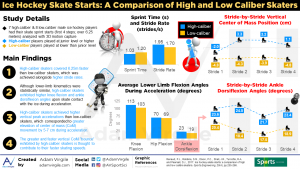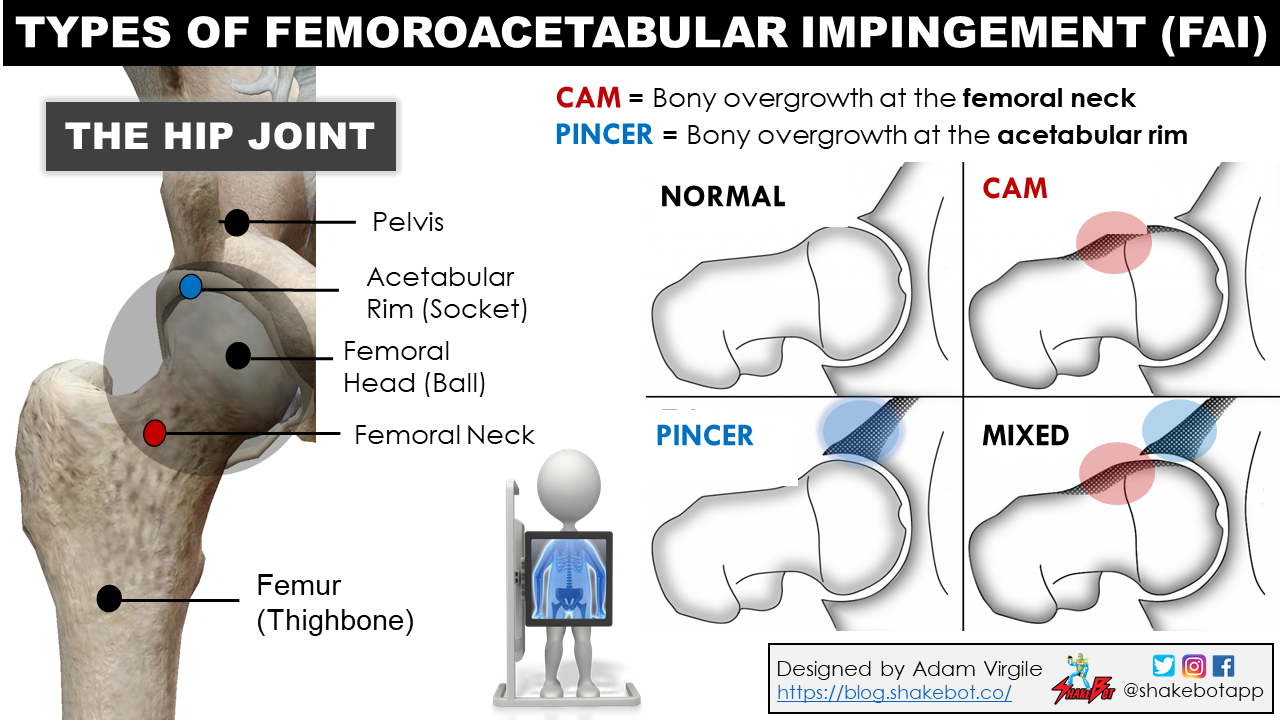If you missed Part 1, you can view it here.
Ice Hockey Requirements and Injury Overview
Ice hockey is a fast-paced, complex, team sport, which demands a combination of quick thinking, fast reactions, and superior all-around athletic skills (i.e. strength, power, speed, stability, balance, and movement quality), [1].
In fact, ice hockey is characterized by explosive skating patterns, where players who are able to increase their speed (i.e. accelerate) at greater rates than their rivals can gain substantial performance advantages [2]. It’s also one of the fastest team sports, with players reaching peak speeds above 40 km/h [3, 4]. Given the metabolically-intense and physical nature of the sport, there’s a high occurrence of injuries sustained by the male ice hockey athlete; previous studies report injury rates between 4.9 injuries/1000 athlete exposures (AE) in NCAA Division I players [5] and up to 15.6 injuries/1000 AE in NHL players [6]. In NCAA men’s ice hockey athletes, 10.3% of all injuries are classified as “severe”, resulting in time loss and restricted participation for > 3 weeks [7]. The risk for severe injury to occur was 8.6x more likely during games compared with practices, and nearly 11% of all severe injuries occurred in the hip/groin/upper leg region [7]. Most of all ice hockey injuries, severe or not, are caused by contact [5-13], but it’s debatably more important to focus on non-contact injury prevention because many of the factors associated with such are modifiable [14], as discussed above.

The Susceptibility of the Hip Complex
The hip complex is among the most common locations of the ice hockey athlete’s body to become injured when both contact and non-contact injuries are taken into consideration [5, 6, 9-11, 13, 15, 16]. Hip injuries are typically caused by non-contact events, with at least 70% of all hip injuries being strains [17]. Most commonly, hip strains occur in the hip flexors and adductors, with at least 81% and 80% of strains, respectively, being caused by non-contact or overuse [17]. Men’s ice hockey also has the highest proportion of hip flexor and adductor strains being recurrent, compared with all other NCAA Men’s sports [18]. In a study investigating injury rates in NCAA Division III men’s hockey athletes over a 4-year period, the hip complex was the most frequently injured site on the body, amassing 50% and 27% of non-contact, and total (non-contact and contact) injuries [19]. This data speaks towards the significance of applying strategies to modify risk factors associated with non-contact hip injury, in order to improve athlete health and longevity. The disproportionate non-contact injury rates of the hip flexors and adductors, relative to the rest of the body, makes sense given their unique eccentric contributions to the recovery phase of the ice hockey stride. The combined modifiable injury potential and robust impact on performance from the hip flexors and adductors warrants special attention. There’s potential to apply screening/monitoring and strengthening procedures for these muscle groups to reduce injury risk and enhance on-ice performance.

Groin Strains in Ice Hockey
In a study involving NHL players, hip adduction strength, but not flexibility, was associated with increased risk for sustaining a subsequent groin strain [20]. Hip adduction strength was 18% lower in the players who subsequently sustained an adductor muscle strain compared with that of uninjured players [20]. Additionally, a player was 17x more likely to sustain an adductor muscle strain if his adductor strength was less than 80% of his abductor strength [20]. In a follow-up study, these researchers put all players identified as “at risk” (i.e. hip adductor/abductor muscle strength ratio less than 80%) on an exercise program emphasizing adductor muscle strengthening [21]. Strengthening the adductor muscle group effectively reduced adductor muscle strains in these “at risk” players [21]. In high school and collegiate hockey players, all players who sustained a groin injury had a preceding bilateral adductor strength imbalance, with the injured limb possessing 75% or less of the strength as the uninjured limb [22].

Groin Strains in Other Sports
Research investigating hip strength and groin injury propensity in ice hockey athletes is limited, but there is a substantial amount of literature in other sports. Isometric hip adduction/abduction strength ratio was significantly lower in elite soccer players with groin pain during hip adduction testing compared with players with a pain-free test [23]. A study in Australian Rules Football (ARF) athletes found that reduced hip adduction strength relative to baseline measures preceded groin pain onset [24]. In a group of 508 amateur male soccer players from Norwegian first, second, and third division teams, there were also associations between hip adductor strength and new groin injuries [25]. Players with previous groin injury or weak adductor muscles were 2.6x and 4.3x more likely to sustain a new groin injury, respectively [25].
In elite tennis players with a history of groin injury, isometric adductor strength and adductor/abductor strength ratios were lower in the injured limb (16.4% and 20.1%, respectively) compared with the uninjured side [26]. Performance during a pre-season adductor squeeze test was able to predict subsequent groin injury in Gaelic football players; increased injury risk was associated with lower adduction strength [27]. A rehabilitation program was applied to a group of 68 football players with longstanding groin pain (40 weeks, on average), [28]. Athletes were assigned to either 1) an active training program aimed at improving strength and coordination of the muscles acting on the pelvis, in particular the adductor muscles, or 2) a physiotherapy treatment without active training for 8-12 weeks. Athletes who did the active training program were 12.7x more likely to make a full return to sports at the same level without groin pain 4 months later [28].
Reviews and Meta-Analyses: Groin Strains in Multiple Sports
A recent meta-analysis found that there is consistent evidence that previous groin injury, higher level of play, reduced hip abductor and adductor strength, and lower levels of sport-specific training are associated with increased risk of groin injury in sport [29]. A separate systematic review was performed in field-based sports (FBS) only and found that previous groin/hip injury was the most prominent risk factor for subsequent hip/groin injury (odds ratio 2.6-7.3), followed by weak hip adductor muscles (odds ratio 4.3), by older age (odds ratio 1.1) and weak adductor muscles (odds ratio 4.3), [30]. Another review of sports-related groin pain (SRGP) found evidence for decreased hip adduction strength, but not internal/external ROM, to be associated with SGRP [31].
A large study of 303 male soccer athletes also found that athletes with past-season groin pain lasting longer than 6 weeks are likely to begin the next season with a high-risk groin injury profile. This high-risk groin injury profile includes hip adductor weakness [32]. Relating to hip range of motion (ROM), a recent systematic review determined that total hip rotation below 85 degrees could differentiate athletes with groin pain from those without [33]. Given the aforementioned research, developing an approach to identify, monitor, and improve hip adductor function in athletes at high-risk for groin injury is warranted.
Summary
Ice hockey involves explosive skating patterns, where players who are able to increase their speed (i.e. accelerate) at greater rates than their rivals can gain substantial performance advantages. Performing these movements requires strong and healthy hips. Since the hip complex is one of the most commonly injured areas in ice hockey athletes, taking proper care of the hip musculature is of high importance for sustained high-level ice hockey performance (and other sports, as well). Athletes with a previous hip injury, weak hip muscles (particularly the adductors/groin muscles), and/or substantial differences in hip strength between limbs, are at high risk for sustaining a hip injury.
For a brief overview of the importance of the hip in ice hockey, go here.
To see the different types of hip/groin injuries that can occur, go here.
To see the costs (financial and other) of injury, including hip injury, go here.
To see how to develop a hip screening and monitoring protocol, go here.
To see how to treat different types of hip pain, go here.
To see how early ice hockey specialization (i.e. year-round participation) can negatively impact the hips, go here.
Enjoying the Content?
Instantly become an important part of the Shakebot community by connecting with me on social media:




Reference
- Buckeridge, E., von Tscharner, V. and Nigg, B.M., 2016, May. LOWER LIMB MUSCLE RECRUITMENT STRATEGIES DIFFER BETWEEN ELITE AND RECREATIONAL ICE HOCKEY PLAYERS. In ISBS-Conference Proceedings Archive (Vol. 33, No. 1).
- Bracko, M.R., 2004. Biomechanics powers ice hockey performance. Biomechanics, 2004, pp.47-53.
- Marino, G.W., 1983. Selected mechanical factors associated with acceleration in ice skating. Research quarterly for exercise and sport, 54(3), pp.234-238.
- Renaud, P.J., Robbins, S.M., Dixon, P.C., Shell, J.R., Turcotte, R.A. and Pearsall, D.J., 2017. Ice hockey skate starts: a comparison of high and low calibre skaters. Sports Engineering, 20(4), pp.255-266.
- Flik, K., Lyman, S. and Marx, R.G., 2005. American collegiate men’s ice hockey: an analysis of injuries. The American journal of sports medicine, 33(2), pp.183-189.
- McKay, C.D., Tufts, R.J., Shaffer, B. and Meeuwisse, W.H., 2014. The epidemiology of professional ice hockey injuries: a prospective report of six NHL seasons. Br J Sports Med, 48(1), pp.57-62.
- Kay, M.C., Register-Mihalik, J.K., Gray, A.D., Djoko, A., Dompier, T.P. and Kerr, Z.Y., 2017. The Epidemiology of Severe Injuries Sustained by National Collegiate Athletic Association Student-Athletes, 2009–2010 Through 2014–2015. Journal of athletic training, 52(2), pp.117-128.
- Ferrara, M.S. and Schurr, K.T., 1999. Intercollegiate ice hockey injuries: a causal analysis. Clinical journal of sport medicine: official journal of the Canadian Academy of Sport Medicine, 9(1), pp.30-33.
- Kuzuhara, K., Shimamoto, H. and Mase, Y., 2009. Ice hockey injuries in a Japanese elite team: a 3-year prospective study. Journal of athletic training, 44(2), pp.208-214.
- McKnight, C.M., Ferrara, M.S. and Czerwinska, J.M., 1992. Intercollegiate ice hockey injuries: a three-year analysis. Journal of athletic training, 27(4), p.338.
- Pettersson, M. and Lorentzon, R., 1993. Ice hockey injuries: a 4-year prospective study of a Swedish elite ice hockey team. British journal of sports medicine, 27(4), pp.251-254.
- Pinto, M., Kuhn, J.E., Greenfield, M.L. and Hawkins, R.J., 1999. Prospective analysis of ice hockey injuries at the Junior A level over the course of one season. Clinical journal of sport medicine: official journal of the Canadian Academy of Sport Medicine, 9(2), pp.70-74.
- Agel, J., Dompier, T.P., Dick, R. and Marshall, S.W., 2007. Descriptive epidemiology of collegiate men’s ice hockey injuries: National Collegiate Athletic Association Injury Surveillance System, 1988–1989 through 2003–2004. Journal of athletic training, 42(2), p.241.
- Meeuwisse, W. H. (1994). Assessing causation in sport injury: a multifactorial model. Clinical Journal of Sport Medicine, 4(3), 166-170.
- Agel, J. and Harvey, E.J., 2010. A 7-year review of men’s and women’s ice hockey injuries in the NCAA. Canadian journal of surgery, 53(5), p.319.
- Tegner, Y. and Lorentzon, R., 1991. Ice hockey injuries: incidence, nature and causes. British journal of sports medicine, 25(2), pp.87-89.
- Dalton, S.L., Zupon, A.B., Gardner, E.C., Djoko, A., Dompier, T.P. and Kerr, Z.Y., 2016. The epidemiology of hip/groin injuries in national collegiate athletic association men’s and women’s ice hockey: 2009-2010 through 2014-2015 academic years. Orthopaedic journal of sports medicine, 4(3), p.2325967116632692.
- Eckard, T.G., Padua, D.A., Dompier, T.P., Dalton, S.L., Thorborg, K. and Kerr, Z.Y., 2017. Epidemiology of hip flexor and hip adductor strains in National Collegiate Athletic Association athletes, 2009/2010-2014/2015. The American journal of sports medicine, 45(12), pp.2713-2722.
- Wilcox, C.R.J., 2015. The development and implementation of a hip injury screening protocol within elite ice hockey (Doctoral dissertation, University of Hull).
- Tyler, T.F., Nicholas, S.J., Campbell, R.J. and McHugh, M.P., 2001. The association of hip strength and flexibility with the incidence of adductor muscle strains in professional ice hockey players. The American journal of sports medicine, 29(2), pp.124-128
- Tyler, T.F., Nicholas, S.J., Campbell, R.J., Donellan, S. and McHugh, M.P., 2002. The effectiveness of a preseason exercise program to prevent adductor muscle strains in professional ice hockey players. The American journal of sports medicine, 30(5), pp.680-683.
- Merrifield, H.H. and Cowan, R.F., 1973. Groin strain injuries in ice hockey: A disparity in muscle strength between both hip joint adductor muscle groups was found to be a contributing factor in groin strain injuries. The Journal of sports medicine, 1(2), pp.41-42.
- Thorborg, K., Serner, A., Petersen, J., Madsen, T.M., Magnusson, P. and Hölmich, P., 2011. Hip adduction and abduction strength profiles in elite soccer players: implications for clinical evaluation of hip adductor muscle recovery after injury. The American journal of sports medicine, 39(1), pp.121-126.
- Crow, J.F., Pearce, A.J., Veale, J.P., VanderWesthuizen, D., Coburn, P.T. and Pizzari, T., 2010. Hip adductor muscle strength is reduced preceding and during the onset of groin pain in elite junior Australian football players. Journal of science and medicine in sport, 13(2), pp.202-204.
- Engebretsen, A.H., Myklebust, G., Holme, I., Engebretsen, L. and Bahr, R., 2010. Intrinsic risk factors for groin injuries among male soccer players: a prospective cohort study. The American journal of sports medicine, 38(10), pp.2051-2057.
- Moreno-Pérez, V., Lopez-Valenciano, A., Barbado, D., Moreside, J., Elvira, J.L.L. and Vera-Garcia, F.J., 2017. Comparisons of hip strength and countermovement jump height in elite tennis players with and without acute history of groin injuries. Musculoskeletal Science and Practice, 29, pp.144-149.
- Delahunt, E., Fitzpatrick, H. and Blake, C., 2017. Pre-season adductor squeeze test and HAGOS function sport and recreation subscale scores predict groin injury in Gaelic football players. Physical therapy in sport, 23, pp.1-6.
- Hölmich, P., Uhrskou, P., Ulnits, L., Kanstrup, I.L., Nielsen, M.B., Bjerg, A.M. and Krogsgaard, K., 1999. Effectiveness of active physical training as treatment for long-standing adductor-related groin pain in athletes: randomised trial. The Lancet, 353(9151), pp.439-443.
- Whittaker, J.L., Small, C., Maffey, L. and Emery, C.A., 2015. Risk factors for groin injury in sport: an updated systematic review. Br J Sports Med, pp.bjsports-2014.
- Ryan, J., DeBurca, N. and Mc Creesh, K., 2014. Risk factors for groin/hip injuries in field-based sports: a systematic review. Br J Sports Med, pp.bjsports-2013.
- Kloskowska, P., Morrissey, D., Small, C., Malliaras, P. and Barton, C., 2016. Movement patterns and muscular function Before and after onset of sports-related groin pain: a systematic review with meta-analysis. Sports Medicine, 46(12), pp.1847-1867.
- Thorborg, K., 2018. Preseason Adductor Squeeze Strength in 303 Spanish Male Soccer Athletes.
- Tak, I., Engelaar, L., Gouttebarge, V., Barendrecht, M., Van den Heuvel, S., Kerkhoffs, G., Langhout, R., Stubbe, J. and Weir, A., 2017. Is lower hip range of motion a risk factor for groin pain in athletes? A systematic review with clinical applications. Br J Sports Med, 51(22), pp.1611-1621.



